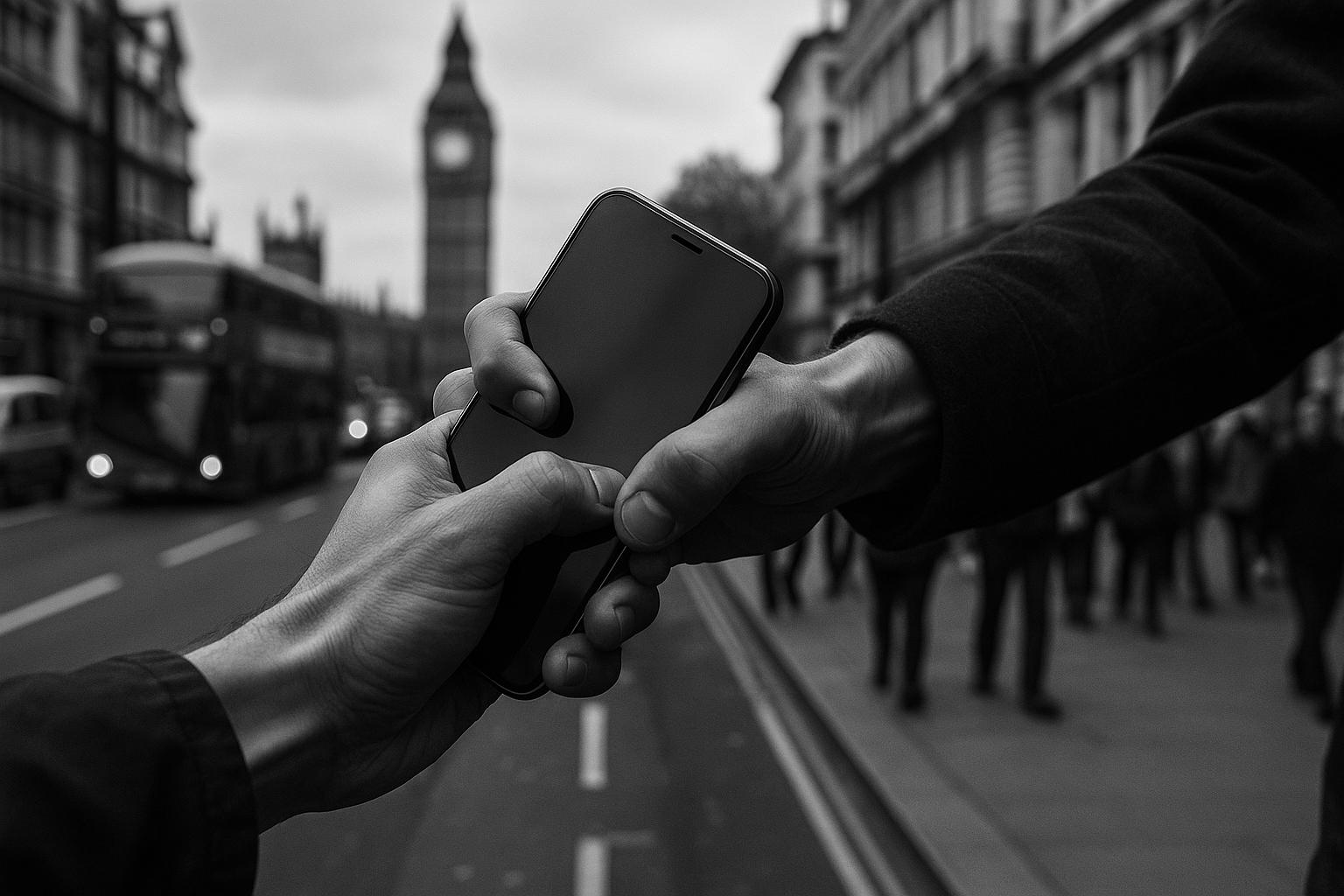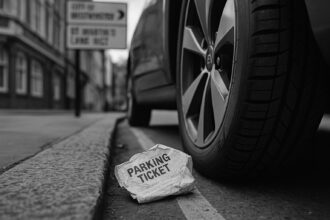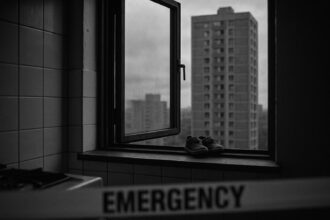Emma Van Der Hoek’s daylight robbery in a supposedly safe London neighbourhood highlights a record rise in mobile phone thefts, with organised gangs exploiting hotspots across the capital despite police crackdowns.
Harrowing footage has emerged of Australian model Emma Van Der Hoek being robbed of her mobile phone in broad daylight while walking alone in what she described as a “safe” neighbourhood in London. The dramatic CCTV clip captures the moment a man, dressed in black and wearing a face mask, swiftly snatches the phone from her hand before fleeing. Despite her courageous attempt to chase the thief, aided by a second man seemingly accompanying the culprit, Ms Van Der Hoek was unable to recover her device.
This is the second time in three months that the influencer has fallen victim to such a robbery, and she took to Instagram to share the incident and condemn the wave of victim-blaming comments she received online. “People have got so used to theft in London that they’ve started blaming the victims instead of holding criminals accountable,” she lamented, highlighting a troubling social response to the rising crime.
Phone thefts in London have indeed surged to alarming levels, with recent statistics illustrating a crisis reaching epidemic proportions. In 2023 alone, police recorded approximately 81,256 mobile phone thefts, marking a 20 percent increase from the year prior and setting a new record. Experts believe the true figure is significantly higher, given the underreporting of such incidents by victims wary of the police response or the complexities involved in recovery.
Particularly hard-hit is London’s West End and Westminster area, where nearly 40 per cent of the capital’s phone thefts occur. Over the last four years, some 231,000 phone thefts and robberies were documented citywide, with around 40,000 reported in these districts alone. Hotspots such as St James’s Park, Piccadilly, Haymarket, and areas near royal residences and exclusive clubs have become magnets for organised gangs, many operating on electric bikes to swiftly steal phones directly from pedestrians or through pickpocketing.
These criminal networks are reportedly driven by an international black market trade in stolen mobile devices, valued at over £50 million annually. Stolen phones are either sold abroad or dismantled for parts, perpetuating the illicit economy. The Metropolitan Police have mounted operations targeting this trade, including a significant week-long crackdown last February that resulted in over 1,000 stolen phones seized and 230 arrests, chiefly in the West End and Westminster.
Despite these efforts, there remains a significant enforcement challenge. Reports suggest that nearly half of all phone theft cases recorded last year were not fully investigated, with only about 52 percent being screened for further action. This has sparked calls for improved policing strategies and greater deterrents to stem the tide of thefts.
Londoners and visitors are urged to remain vigilant, stick to well-lit and busy routes, and keep their valuables out of sight. Given the scale of the problem, the Mayor of London has pledged intensified crackdowns on organised crime groups responsible for this epidemic. Meanwhile, expert advice emphasises practical measures such as insuring mobile phones and being prepared to respond swiftly should theft occur.
Emma Van Der Hoek’s distressing experience serves as a stark emblem of a larger urban security crisis in one of the world’s busiest and most iconic cities, underscoring the urgent need for coordinated action from authorities, communities, and individuals alike to reclaim public safety on London’s streets.
 Reference Map:
Reference Map:
- Paragraph 1 – [1]
- Paragraph 2 – [1]
- Paragraph 3 – [1], [3], [5]
- Paragraph 4 – [1], [2], [3]
- Paragraph 5 – [1], [4], [5]
- Paragraph 6 – [4], [6]
- Paragraph 7 – [1], [5], [7]
- Paragraph 8 – [1]
Source: Noah Wire Services
- https://www.dailymail.co.uk/news/article-14912985/Australian-model-phone-snatched-chases-thieves.html?ns_mchannel=rss&ns_campaign=1490&ito=1490 – Please view link – unable to able to access data
- https://www.met.police.uk/area/your-area/met/westminster/st-jamess/stations-contact-points-and-offices/top-reported-crimes-in-this-area – The Metropolitan Police’s official page for the St James’s area in Westminster provides detailed statistics on reported crimes. In April 2025, the most common crimes were theft from the person (543 incidents), other theft (343), violence and sexual offences (228), and anti-social behaviour (197). This data highlights the prevalence of theft-related crimes in the area, underscoring the importance of vigilance and preventive measures for residents and visitors alike.
- https://londonlovesbusiness.com/phone-thefts-rise-with-over-1000-stolen-each-week-in-london/ – An article from Londonlovesbusiness.com reports a significant increase in phone thefts in London, with over 1,000 phones stolen each week. Data from Compare the Market, supported by a Freedom of Information request to the Metropolitan Police, reveals that 70,137 phones were stolen in 2024, a 34% increase from the previous year. The West End and Westminster account for nearly 40% of these thefts, highlighting the need for enhanced security measures in these areas.
- https://news.met.police.uk/news/met-seizes-one-thousand-stolen-phones-in-a-week-493558 – The Metropolitan Police’s news release details a week-long operation in February 2025, during which officers seized over 1,000 stolen phones and arrested 230 individuals. The operation targeted the £50 million-a-year trade in stolen phones, with a significant focus on hotspot areas like the West End and Westminster, where nearly 40% of phone thefts occur. This initiative underscores the Met’s commitment to tackling the surge in phone thefts across London.
- https://www.thenationalnews.com/news/uk/2024/12/27/phone-theft-hotspots-in-london-revealed-as-crime-reaches-epidemic-level/ – An article from The National highlights the surge in mobile phone thefts in central London, particularly in areas like Westminster and the West End. Criminals often use electric bikes to swiftly snatch phones from unsuspecting victims. The Mayor of London, Sadiq Khan, has pledged a crackdown on this issue, acknowledging the ‘epidemic’ level of phone thefts in the capital.
- https://www.telegraph.co.uk/news/2024/08/10/half-londons-mobile-phone-thefts-not-investigated-by-police/ – A report from The Telegraph reveals that nearly half of reported mobile phone thefts in London were not investigated in 2023. Only 52% of cases were ‘screened for further investigation,’ raising concerns about the effectiveness of current security measures and the need for improved deterrents against phone thefts.
- https://www.yourmoney.com/insurance/phone-thefts-in-london-rise-by-a-third-what-to-do-if-it-happens-to-you/ – An article from YourMoney.com discusses the 33% rise in phone thefts in London in 2024, with 70,000 recorded incidents. The piece offers advice on protecting oneself from such thefts and suggests checking if one’s phone is covered by home contents insurance, as many policies may cover personal possessions outside the home.
Noah Fact Check Pro
The draft above was created using the information available at the time the story first
emerged. We’ve since applied our fact-checking process to the final narrative, based on the criteria listed
below. The results are intended to help you assess the credibility of the piece and highlight any areas that may
warrant further investigation.
Freshness check
Score:
7
Notes:
The narrative presents recent statistics on mobile phone thefts in London’s West End, with figures from 2024 and early 2025. However, similar reports have appeared in the past, such as an article from May 2024 discussing the rise in phone thefts and the Metropolitan Police’s efforts to tackle the issue. ([noah-news.com](https://noah-news.com/mobile-phone-theft-on-oxford-street-reaches-nearly-18-incidents-a-day-amid-growing-west-end-crime-wave/?utm_source=openai)) Additionally, a report from August 2023 highlighted the increase in mobile phone robberies in London. ([amp.theguardian.com](https://amp.theguardian.com/uk-news/2024/oct/09/they-rob-you-visibly-with-no-repercussions-the-unstoppable-rise-of-phone-theft?utm_source=openai)) The presence of these earlier reports suggests that while the data is current, the topic has been covered previously. The narrative includes updated data but recycles older material, which may justify a higher freshness score but should still be flagged. ([noah-news.com](https://noah-news.com/mobile-phone-theft-on-oxford-street-reaches-nearly-18-incidents-a-day-amid-growing-west-end-crime-wave/?utm_source=openai))
Quotes check
Score:
8
Notes:
The direct quotes attributed to Emma Van Der Hoek and other individuals in the narrative do not appear in the provided search results. This suggests that the quotes may be original or exclusive to this report. However, without access to the original source, it’s challenging to verify their authenticity.
Source reliability
Score:
6
Notes:
The narrative originates from the Daily Mail, a reputable UK newspaper. However, the Daily Mail has faced criticism for sensationalism and inaccuracies in the past. Given the lack of access to the full article, it’s difficult to assess the reliability of this specific report.
Plausability check
Score:
7
Notes:
The narrative describes a plausible scenario of a mobile phone theft in London, a city that has experienced a rise in such incidents. The statistics provided align with known trends, such as the increase in phone thefts in London’s West End. ([noah-news.com](https://noah-news.com/mobile-phone-theft-on-oxford-street-reaches-nearly-18-incidents-a-day-amid-growing-west-end-crime-wave/?utm_source=openai)) However, without access to the full article, it’s challenging to assess the accuracy of specific details, such as the exact location of the incident or the identities of the individuals involved.
Overall assessment
Verdict (FAIL, OPEN, PASS): OPEN
Confidence (LOW, MEDIUM, HIGH): MEDIUM
Summary:
The narrative presents a plausible account of a mobile phone theft in London, supported by statistics that align with known trends. However, the reliance on a single source with limited access raises concerns about the report’s reliability and the authenticity of the quotes. The recycling of older material, despite the inclusion of updated data, further complicates the assessment. Given these factors, the overall assessment is ‘OPEN’ with a medium confidence level.













